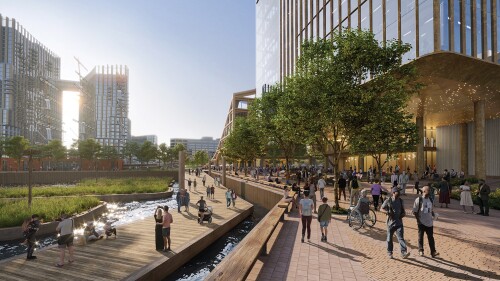The Jordan Downs affordable housing project is the centerpiece of several community-serving revitalization projects emerging in Watts.
Community revitalization is an undeniably long and complex process. With so many challenges, redevelopment projects in underinvested communities often fail to gain momentum—but the Jordan Downs Redevelopment plan in Watts, an enclave of Los Angeles, California, is a model for how to get it right. The decades-long project is starting to take shape, and it could serve as a model for how other cities could pursue large-scale redevelopments.
The Housing Authority of the City of Los Angeles (HACLA) led the initiative to redevelop Jordan Downs, a 21-acre (8.5 ha) site, into more than 1,700 units of affordable housing, 115,000 square feet (10,683.9 sq m) of retail and 45,000 square feet (4,180 sq m) of ground-floor commercial space. At the Urban Land Institute’s Building Healthy Places Forum during the Fall 2023 Meeting, community leaders and project stakeholders discussed the success at Jordan Downs and other projects transforming the community.
Maximizing affordable housing supply
The Jordan Downs site made Watts a primary candidate to win redevelopment dollars from HACLA. The site provided a 21-acre (8.5 ha) redevelopment opportunity adjacent to an existing public housing project. As a result, HACLA was able to demolish and rebuild dated and failing buildings and maximize the affordable housing supply on the site. The project started in 2017 and is estimated to deliver between 2027 to 2029. Once complete, the project will increase the affordable housing supply from 700 units to more than 1,700 units.
HACLA had a strict one-for-one replacement policy, meaning that no existing residents would be displaced from their homes. The project has been carefully planned and mapped to move residents into the new housing units before their homes are demolished. The sheer size of the development site allowed HACLA to keep residents in their homes, because they could build first before demolishing the original structures. In total, the project has represented a $1.5 billion investment in the community of Watts.
Earning community trust
The residents of underserved communities are often hesitant to trust elected officials and their promises. To gain community trust, HACLA worked closely with community leaders and encouraged community input in the project. HACLA created the Jordan Downs Resident Advisory Council, a group of community stakeholders that had a seat at the table, to determine the redevelopment plan. “It is hugely important that, as we invest in the property, we also invest in the people,” says John King, director of community engagement at HACLA. “We are in this together, and we want to transform the community.”
Outside of the council, there was tremendous community outreach and engagement not only to gain input but also to educate people about the project, answer questions, and quell concerns. The master plan was created with tremendous community involvement, which King says, “can’t be minimized in any way.”
More than just rooftops
Although affordable housing is HACLA’s primary mission, there is more to community revitalization than simply providing housing. It’s one reason that the Jordan Downs project also included retail, parks, and commercial space.
Beyond Jordan Downs, other important community-serving projects and programs are emerging. MudTown Farms and Watts Rising, a group of more than 40 local organizations, spoke at the forum about the revitalization happening throughout the community and the importance of community engagement for success. “It is vital for the community to get involved,” said Angelica Urquidez, a member of Watts Rising and a native of the community, during her discussion of the Watts revitalization. “There is a sense of pride in growing up here.”








